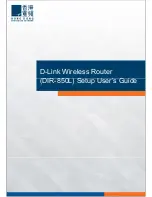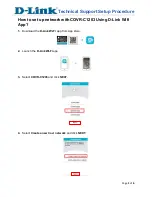
RF Configure Menu
37
Configuring the Wireless Access Point
Table 5-6. Wireless Settings Submenus
Item
Description
Enable Radio
Select Yes to turn on the wireless function.
Country/Region
Select your country/region from the drop-down list.
Radio frequency regulations and working channels vary in differ-
ent country. Make sure to select your correct location.
Operating Mode
AP Mode establishes a wireless coverage network and allows the
connection to wireless terminals.
Bridge Mode establishes a point-to-point, point-to-multipoint
wireless bridge.
Note: Card 1 supports only AP mode. Card 2 supports both AP
and Bridge Modes.
Wireless Mode
802.11b/g (Auto) establishes an 802.11b/g network. Both
802.11b and 802.11g wireless stations may be used. It also sup-
ports wireless stations configured with 108Mbps.
802.11b only establishes an 802.11b network. 802.11g wireless
terminals can still be used if they can operate in 802.11b mode.
802.11g only establishes an 802.11g network. An 802.11b wire-
less terminal cannot access this network.
802.11b/g/n establishes an 802.11b/g/n network.
802.11n (2.4G) establishes an 802.11n wireless node working in
2.4G band.
Basic Speed
Shows the basic radio transmit speed.
Support Speed
Shows other radio transmit speeds supported.
Channel/Frequency
Select the working channel according to the frequency plan within
your country/region.
Data Rate
Set the transmission rate. Select Auto to get the transmission
rate according to the environment.
RTS Threshold
Request to Send (RTS) is used to solve network conflicts when
two sites send data to the AP simultaneously. When a data packet
is larger than the threshold value, the sending site notifies the AP.
The AP then informs other sites to postpone data transmission,
then notifies the first site to send the data.
Beacon Interval
Synchronizes the wireless access point connected to the packet
of wireless terminal. The effective range of beacon interval is from
20 to 1000. Recommend to use the default value.
DTIM Time Interval
Set the interval of Delivery Traffic Indication Message, which is
used to inform clients of the next window for listening to broadcast
and multicast information.
Preamble Type
The 802.11g standard supports Long (128 bits) and short (56
bits). The 802.11b standard only supports short.
Short preamble improves the overall utilization of the wireless
channel to achieve higher priority transmission bandwidth.
Long preamble is recommended when the environment has
more interference.
Set to Auto to get the optimum performance.
















































